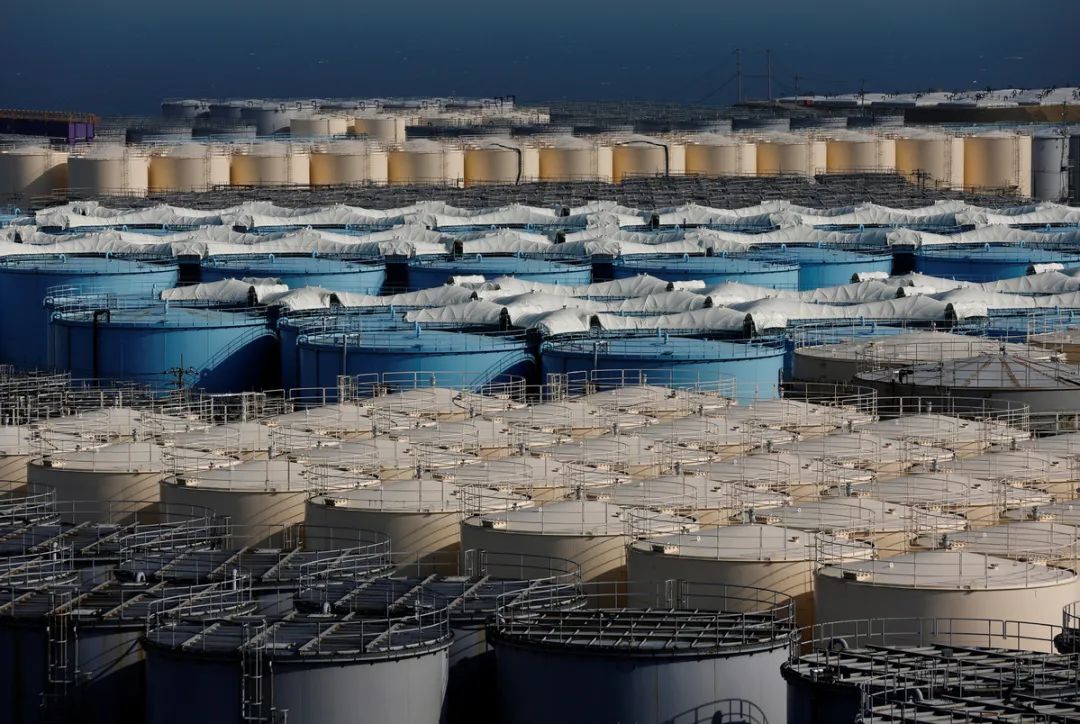Swimming in Fukushima nuclear-contaminated water is absurd

Tanks containing water from the disabled Fukushima Dai-ichi nuclear power plant are seen at the power plant in Okuma town, Fukushima prefecture, Japan, March 8, 2023. [Photo/Agencies]
The IAEA released its report on the safety review of the nuclear-contaminated water at the Fukushima Daiichi Nuclear Power Station, which attracted wide international attention. The foreword to the report states clearly that it is neither a recommendation nor an endorsement of the Japan's ocean discharge policy. Furthermore, the report does not fully reflect the views of all experts participating in the review, and relevant safety conclusion is narrow with limitations. Therefore, such a report should not be regarded as a "shield" or "greenlight" for Japan's discharge plan.
Japan's discharge plan is unprecedented. On the disposal of the Fukushima nuclear-contaminated water, there are options including long-term storage, hydrogen release, geosphere injection, underground burial, and vapor release. Japan has chosen the discharge plan with minimum cost among all options. Ocean discharging is not the safest or most optimal one, nor has it been widely accepted by Japan's neighbors or Pacific Islands countries. Japan requested the IAEA to undertake a safety review only after it made the decision on discharging the water into the ocean, and continually seeking the endorsement by the IAEA in every possible way. Japan's requirement on the IAEA safety review on the ocean discharge plan is extremely selective, which excluded any other options. No matter who conducts such a review, there is no way to assess and justify the legitimacy of Japan's ocean discharge plan.
Drawing a simple analogy between the discharge of nuclear-contaminated water from the Fukushima nuclear accident and effluent from nuclear power plants in normal operation in other countries is against the common scientific knowledge. Someone even claimed that the discharged nuclear-contaminated water can be used for drinking or swimming. This is absurd. The nuclear-contaminated water comes from the cooling water injected into the damaged reactor core after the nuclear accident, as well as infiltrated undergroundwater and rainwater. Compared with the effluent from normally operational nuclear power plants, the nuclear-contaminated water comes from different sources, contains different types of radioactive nuclides and varies in treatment difficulty level. They are fundamentally different matters.
The conclusion of the IAEA report on the safety of Japan's ocean discharge plan is quite narrow. The IAEA interlaboratory comparisons were only limited to a small number of samples collected by Japan, and the assessment made was solely based on information provided by Japan. Therefore, the conclusion in the report is not convincing enough and lacks credibility. In addition, the IAEA, restricted by its mandate, has not assessed the long-term effectiveness of Japan's purification facilities, has not verified the accuracy of relevant data, and cannot ensure the international community to be informed timely when the radioactive concentration in discharged water exceeds the discharge limits. It is even more difficult to predict the impact of long-term accumulation and concentration of radionuclides bring to the marine ecosystems, food safety, and public health. Since data accuracy, equipment reliability and effective safety regulation cannot be ensured, it is impossible to draw the conclusion that it is safe to discharge more than 1.3 million tons of nuclear-contaminated water into the ocean more than three decades.
China is seriously concerned and strongly opposes to Japan's decision. We urge that Japan's disposal of the nuclear-contaminated water should be in a science-based, safe and transparent manner, and Japan should not forcibly push through its ocean discharge plan. Moreover, China insists that the IAEA should take the lead in establishing an independent and effective international monitoring mechanism, with full participation of third-party laboratories, especially those from neighboring countries of Japan, to conduct long-term and effective international monitoring on the ocean discharge plan that has been consistently pushed forward by Japan. The mechanism should include monitoring on the source term of the Fukushima nuclear-contaminated water and the environment, and radiation environmental impact assessment, release in a timely and transparent manner credible data and information to stakeholders and international community, and subject itself to oversight and questioning.
Over the past week, the people of Japan's neighbors and Pacific island countries have increasingly expressed doubts and opposition to Japan's ocean discharge plan as well as to the IAEA report. The public opinion shall not be ignored. The narrow conclusion from the IAEA report and the absurd idea of swimming in the contaminated water cannot conceal the long-term and uncertain risks to the people and the environment caused by the discharge of Fukushima nuclear-contaminated water into the ocean. Once again, China urges Japan to stop the ocean discharge plan, otherwise it should bear all consequences arising from it and historical responsibilities. The IAEA should take on a responsible and professional role.
The author is permanent representative of China to the UN and other International Organizations in Vienna, permanent representative of China to the IAEA.